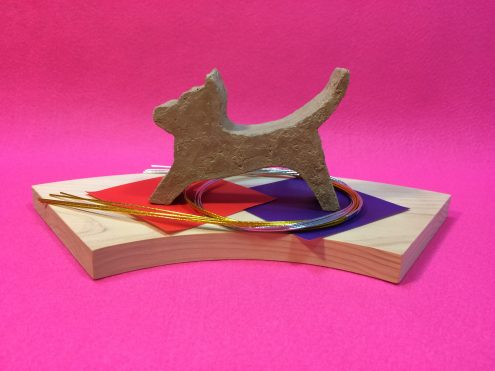 Nakayama Michi 2018 New Year’s Decoration (Zodiac figurine)
Nakayama Michi 2018 New Year’s Decoration (Zodiac figurine)
2018 “byo byo”1000 yen (includes tax)
tosa mountain soil
W11×H7×D2.6 cm
(tosa cypress fan-shaped pedestal sold separately)1000 yen each (tax included)
※ Shipping also available out of prefecture (see homepage)
There is an onomatopoetic word for the cry of a dog, pronounced “byo byo byo”.
The Edo-era is considered to be the first time Japanese people began to keep dogs as pets using leashes. Before this, dogs were mostly wild and let to run free. The barking sound of these truculent creatures was much different than that of the sweet pets of today. The “byo” heard often in Noh plays and such represents that former interpretation. Likewise, the shift to the currently used “wan wan” reveals how the pet-keeping environment has changed with the times. Additionally, it can be used to exemplify that Japan is a country of native expressions including an incredible amount of mimetic words and onomatopoeia. These onomatopoeias have an existence in our daily lives that is irreplaceable. This time around I’ve decided to make a work that explores those Japanese roots.
●artist’s intention
This ornament artwork is not fired pottery and is very fragile. If by chance the piece breaks by accident please don’t feel upset or that it has been wasted. Instead please feel that it has served its function. If you feel the piece has fulfilled its purpose and no longer need it, please dispose of it by returning it to the earth. It is natural for all things to lose their shape over time. Such is the function of these pieces. Soil truly is the foundation of everything in the natural world.
By returning “byo byo” to the ground, you give it a new life where it can continue to watch over the world and become a work that symbolizes the mutual prosperity of man and nature.
●art making process
Red clay salvaged from nearby mountains is let to dry in the sun. Once the soil has been dried, it is sifted to extract the fine dirt. There, shredded straw and water is needed and left overnight. After the moisture concentration is adjusted, each clay figure can be sculpted by hand and dried naturally. Because these pieces are not fired pottery, they are highly fragile and contact with water is strictly prohibited.

The new year’s decoration(Zodiac figurine)
Readying the clay
1 Dirt is collected from the mountainside
2 Dirt taken from the mountain is set to dry in the sun
3 The dried soil is then sifted the acquire the minute dirt particles
4 Rice plants taken from the fields are dried and cut very finely
5 Water is added to the sifted soil and cut straw mixture
6 The mixture is stirred thoroughly before adjusting the water concentration
7 After several days the moisture is removed- creating a sticky concoction
(This can vary depending on the time and season)
8 The mixture is then kneaded into one lump
The clay making process is now finished
 Shaping
Shaping
1 From here we can create each shape
2 A knife is used to create a rough outline
3 Excess material is removed with the knife
4 The underside of the piece is marked with a seal
5 The figure is then set out to dry
6 The piece has been left to dry naturally
7 An underlying charm is brought out with the brush
Now the general structure is completed
This is the end of the molding process



Packaging
A label is placed onto the box
The piece is placed into the box along with a caption
The packing phase is completed
The last of bagging
That’s all there is to it


This is the 11th time creating work for the zodiac series.
As I create these decorative works for each New Year, I’ve come to realize; Part of my task in producing these pieces is to insert a spirit, not something one can see with the eye, but rather a feeling, and it is my hope that you might sense this feeling in holding one for yourself.
